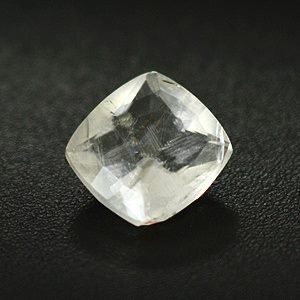Whewellite is a mineral, hydrated calcium oxalate, formula CaC2O4·H2O. Because of its organic content it is thought to have an indirect biological origin and this is supported by it being found in coal and sedimentary nodules. However, it has also been found in hydrothermal deposits where a biological source appears improbable. For this reason it can be classed as true mineral.
Olmite ideally is a newly identified mineral from the N’Chwaning II mine of the Kalahari manganese fields (Republic of South Africa), which occurs as a product of hydrothermal alteration associated with poldervaartite, celestine, sturmanite, bultfonteinite and hematite.Olmiite is the Mn2 +-dominant analogue of Poldervaartite. Colors are pale to intense reddish pink. It is a product of hydrothermal alteration. It is a beautiful gemstone!
http://freakingcat.com/products/olmite
Grandidierite, named after the French explorer Alfred Grandidier, is one of the all time classics in the rare gemstone market. It is virtually impossible to find clear gems and collectors are happy to get mineral quality gems. A classic location in the jungle of Madagascar is “lost” and it is unlikely that it ever will be rediscovered again. Find grandidierites at www.freakingcat.com
A rare, big sized, 14.56 cts, bright red Polyhalite, which easily dissolves in water. Polyhalite is an evaporite mineral, a hydrated sulfate of potassium, calcium and magnesium with formula: K2Ca2Mg(SO4)4·2(H2O). Polyhalite crystallizes in the triclinic system although crystals are very rare. The normal habit is massive to fibrous. It is typically colorless, white to gray, although it may be brick red due to iron oxide inclusions. It has a Mohs hardness of 3.5 and a specific gravity of 2.8 – Find it at www.freakingcat.com
Anatase is one of the three (mindat says 5) mineral forms of titanium dioxide, the other two being brookite and rutile. Very hard to find eyeclean specimen, which are stunning when facetted. Find more rare collector stones at www.freakingcat.com
Apache tears are rounded nodules of obsidian (volcanic black glass) with diameter from about 0.5 to 5 cm. An Apache tear looks opaque by reflected light, but translucent when held up to light. Apache tears are usually black, but can range from black to red to brown. They are often found embedded in a greyish-white perlite matrix
The name “Apache tear” comes from a legend of the Apache tribe: about 75 Apaches and the US Cavalry fought on a mountain overlooking what is now Superior, Arizona in the 1870s. Facing defeat, the outnumbered Apache warriors rode their horses off the mountain to their deaths rather than be killed. The wives and families of the warriors cried when they heard of the tragedy; their tears turned into stone on hitting the ground. Find more rare collector gemstones at www.freakingcat.com
Spherocobaltite (or Cobalto Calcite) is a manganese carbonate mineral with chemical composition CoCO3. In its (rare) pure form, it is typically a rose-red color, but impure specimens can be shades of pink to pale brown. Find more rare collector gemstones at www.freakingcat.com
Laumontite is a mineral of the zeolite group. Laumontite easily dehydrates when stored in a low humidity environment. When freshly collected, if it has not already been exposed to the environment, it can be translucent or transparent. Over a period of hours to days the loss of water turns it opaque white. In the past, this variety has been called leonhardite, though this is not a valid mineral species. The dehydrated laumontite is very friable, often falling into a powder at the slightest touch. Best keep it hydrated folks! Find more rare collector gemstones at www.freakingcat.com
Narsarsukite – Named after the original location in Greenland, but it can also be found in Canada, Mount St. Hillaire. It comes in green or even more rare in yellow and is usually embedded in rock. It’s a challenge to cut out this material from the rough rock and facet it. Find more rare collector gemstones at www.freakingcat.com






